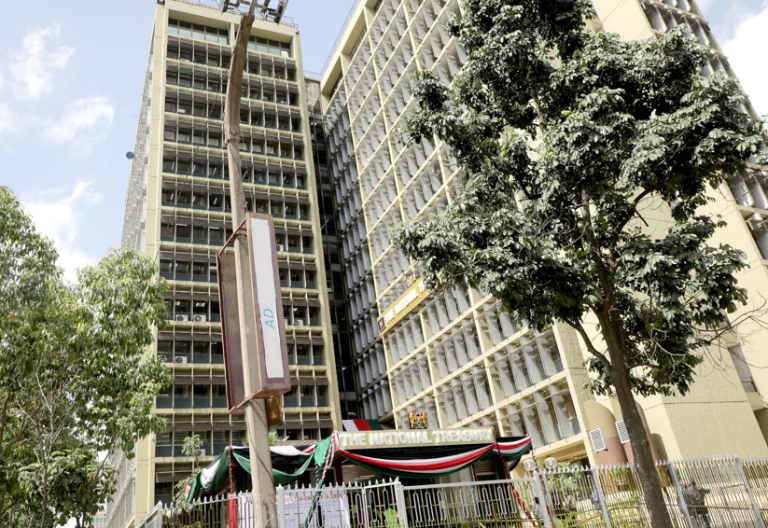Kenya heaving under historic Sh11.5trn debt

Kenya finds itself trapped under the crushing weight of Sh11.5 trillion in public debt as non-performing loans surge to 17.6 percent – one of the highest levels in the country’s history.
This backdrop of a financial crisis has forced the government to unveil its most ambitious budget yet: Sh4.3 trillion for the 2025/26 financial year, representing 22 percent of the nation’s GDP.
Budget of necessity
Treasury Cabinet Secretary John Mbadi, delivering his first budget statement, painted a stark picture of Kenya’s economic reality. The country faces soaring public debt, widening financing gaps, and stagnant revenues while households and businesses struggle with mounting costs.
The numbers tell a troubling story. As of April 30, Kenya’s public debt had grown by Sh300 billion since February, meaning the government borrows roughly Sh100 billion monthly, or Sh33 billion daily. In just nine months, the Office of the Controller of Budget estimates Sh780 billion was added to the debt stock. Of the total debt burden, domestic obligations account for 53.6 percent (Sh6.2 trillion), while foreign lenders hold 46.4 percent (Sh5.3 trillion).
To fund the budget deficit of Sh973 billion, the Treasury plans external borrowing of Sh287.7 billion and domestic borrowing of Sh635.5 billion. Even with Sh469 billion expected from grants, the fiscal deficit remains significant at 4.8 percent of GDP.
Debt servicing trap
Perhaps most concerning is how debt obligations are consuming the budget. Treasury data shows Sh1.1 trillion earmarked for debt repayment, primarily interest payments. This represents nearly one-third of all projected revenue, leaving diminished resources for essential services like healthcare, education, infrastructure, and social protection.
“In this budget, our priority is to strike a delicate balance between fiscal consolidation and maintaining momentum for economic recovery,” Mbadi told Parliament optimistically. He projected that “Kenya’s public debt is projected to remain within sustainable levels over the medium term,” with debt-to-GDP ratios declining “from 63.0 percent in 2024 towards the debt anchor of 55 plus or minus 5 percent of GDP by 2028.”
Despite this optimism, Mbadi defended continued borrowing, noting the government would explore emerging funding instruments including debt swaps, diaspora bonds, sustainability-linked bonds, and Environmental, Social and Governance debt instruments.
Expert scepticism
Economic experts view this rhetoric skeptically. The Institute of Economic Affairs notes that Sh1.72 trillion has been allocated to recurrent spending – including salaries and government operations – while only Sh704.4 billion supports development expenditure that could actually spur growth.
The World Bank warns that global public debt trends are alarming, with projections approaching 100 percent of GDP by decade’s end. This limits governments’ ability to respond to emergencies or invest in essential services, particularly affecting developing nations like Kenya.
“Governments, particularly those in emerging market and developing economies, face both mounting debt service costs and shrinking room to maneuver in government budgets,” explains the World Bank’s Yan Liu. “The result is fewer resources for social programmes or investments, reduced capacity to respond to shocks, and higher borrowing costs.”
Real-world impact
This fiscal imbalance manifests in deteriorating conditions for ordinary Kenyans. Citizens face crumbling infrastructure, underfunded schools, and limited access to clean water. Beatrice Mwangi, a hawker in Nairobi’s city centre, captures the grassroots reality: “I haven’t sold a single item today, and my children still expect food. The price of maize flour keeps going up, but customers have no money.”
High inflation and reduced consumer demand have worsened the economic outlook. Kenya’s tax burden – currently 19 percent of GDP – is more than double that of advanced economies like Austria and the Netherlands, according to World Bank data. This high tax wedge has pushed many workers into the informal economy, reducing Pay As You Earn tax collections.
Revenue streams are also under pressure. Kenya Revenue Authority Deputy Commissioner Gideon Muhwa reported that VAT revenue fell 11 percent in recent months, compared with three percent growth in February, signalling declining consumer spending and businesses’ limited capacity to absorb costs.
Dangerous dependencies
To meet short-term cash needs, the government increasingly relies on Treasury bills. The Central Bank of Kenya (CBK) reported that a recent Treasury bill auction attracted bids worth Sh61.4 billion – well above the Sh24 billion offered. While this suggests strong investor appetite, it underscores the government’s growing dependence on short-term, high-risk borrowing.
This domestic borrowing surge threatens to crowd out private sector credit access. Although CBK data shows private sector lending grew two percent since January to Sh80.9 billion, banks remain cautious as non-performing loans (NPLs) climbed to 17.6 percent in June from 17.2 percent in April, with increases in trade, construction, and personal loans.
CBK Governor Kamau Thugge acknowledged that “banks have continued to make adequate provisions for the NPLs” but rising loan defaults reveal underlying economic fragilities, particularly among small and medium enterprises struggling with cash flow and repayment capacity.
International complications
Adding to structural challenges, the European Union recently listed Kenya as a high-risk jurisdiction for anti-money laundering and terrorism financing compliance. This designation, aligning with Financial Action Task Force updates, places Kenya alongside countries like Angola, Côte d’Ivoire, and Venezuela. The listing could increase international financial transaction costs and complicate access to affordable credit lines.
Burden per citizen
The mathematics are sobering: with total public debt of Sh11.5 trillion divided among Kenya’s 53.331 million citizens, each person carries a theoretical debt burden of Sh215,634. This stark figure illustrates how the country is living well beyond its means.
Last fiscal year alone, Kenya added Sh780 billion to its debt stock in nine months, with Sh524.6 billion from external borrowing. For the 2024/25 fiscal year, debt servicing consumes Sh2.04 trillion of the national budget, emphasising how much of the nation’s resources are tied up in repaying past obligations.
Path forward
Despite Treasury attempts to project fiscal prudence, the heavy reliance on debt to plug deficits and service past obligations creates a vicious cycle. Unless revenue mobilisation improves dramatically or debt restructuring is pursued more aggressively, Kenya risks sliding deeper into a debt trap.
“We must deepen domestic resource mobilisation and enhance efficiency in spending if we are to meet our development goals while staying within sustainable debt limits,” Mbadi told Parliament.














